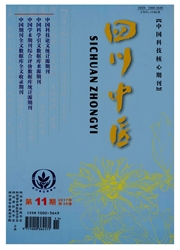

 中文摘要:
中文摘要:
目的:观察解毒通络法对心肌缺血再灌注损伤(MIRI)兔血清C反应蛋白(CRP)、一氧化氮(NO)及磷酸激酶(CK)含量的影响,探讨其抗心肌缺血再灌注损伤的作用机制。方法:大耳白兔32只,健康,雄性,体重2.5—3.0kg。随机分为4组,即假手术组,I/R模组,中药(加味小陷胸汤)治疗高剂量组和低剂量组,每组8只。治疗组于开胸前5天连续灌胃中药,每日1次;其余2组灌胃等剂量生理盐水每日1次,连续5天。然后建立兔I/R模型,实验结束时从右心房采集血液标本检测各组血清中CRP、NO和CK的含量。结果:兔心肌缺血再灌注后I/R模型组血清CRP、NO和CK含量与假手术组比较差异显著(P〈0.01);中药治疗组可以对抗CRP、CK升高和NO下降,与I/R模型组比较差异显著(P〈0.05或P〈0.01)。结论:解毒通络法能够减轻兔心肌缺血再灌注损伤,其可能机制与减少心肌细胞释放CRP,抑制炎症反应;升高NO,减少心肌酶漏出,减缓内皮损伤有关。
 英文摘要:
英文摘要:
Objectives: To observe the effect of dispelling toxins and dredging collaterals therapy on the levels of serum C-reactive protein (CRP), nitric oxide (NO) and ereafine kinases (CK) and explore the mechanism against myocardial ischemia repeffusion injury {MIRI) in rabbits.Methods: Totally 32 rabbits with big ears, of male, weighting 2.5-3.0kg, were divided randomly into 4 groups ( n = 8 in each group) : sham operation group, model group, Traditional Chinese Medicine (Additional Xiao Xianxiong decoction) high dosage group and low dosage group. Rabbits sham operation group and the model group were perfused with saline while rabbits in Traditional Chinese Medicine treatment group were perfused with Additional XiaoXianXiong decoction per day for 5 successive days.Then the experimental model of MIRI was established and then the serum CRP, NO and CK contents were tested in right arterial blood which would be extracted at the end of the experiment. Results: After ischemia reperfusion, the contents of CRP, NO and CK in model group were significantly different as compared with those in sham operation group ( P 〈 0.01 ) ; Furthermore, after treating in the treatment group, the levels of CRP and CK significantly decreased while the levels of NO significantly increased compared with those in model group ( P 〈 0.05, 0.01 ) . Conclusion: The effect of dispelling toxins and dredging collaterals therapy alleviating rabbit myocardial ischemia reperfusion injury may associate with decreasing the level of CRP released by cardiac muscle cells to suppress inflammation reaction; increasing the level of NO to protect the cardiac muscle cells.
 同期刊论文项目
同期刊论文项目
 同项目期刊论文
同项目期刊论文
 期刊信息
期刊信息
